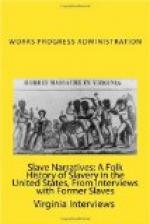How Freedom Came
“My father and mother and grandmother said the overseer told them that they were free. I guess that was in 1865, the same year I was born. The overseer told them that they didn’t have any owner now. They was free folks. The boss man told them too—had them to come up to the big house and told them they had to look out for themselves now because they were free as he was.
Right After the War
“Right after emancipation, my folks were freed. The boss man told them they could work by the day or sharecrop or they could work by groups. A group of folks could go together and work and the boss man would pay them so much a day. I believe they worked for him a good while—about seven or eight years at least. They was in one of the groups.
Earliest Recollections
“My own earliest recollections was of picking cotton in one of those squads—the groups I was telling you about. After that, the people got to renting land and renting stock for themselves. They sharecropped then. It seems to me that everybody was satisfied. I don’t remember any one saying that he was cheated or beat out of anything.
Schooling
“We had a public school to open in Jefferson County, Mississippi. We called it Dobbins Bridge. There was a bridge about a mile long built across the creek. We had two colored women for teachers. Their names was Mary Howard and Hester Harris. They only used two teachers in that school. I attended there three years to those same two women.
“We had a large family and I quit to help take care of it.
Ku Klux
“I don’t think there was much disturbance from the Ku Klux on that plantation. The colored folks didn’t take much part in politics.
Later Life
“I stopped school and went to work for good at about fifteen years. I worked at the field on that same plantation I told you about. I worked there for just about ten years. Then I farmed at the same place on shares. I stayed there till I was ’bout twenty-six years old. Then I moved to Wilderness Place in the Cotton Belt in Mississippi. I farmed there for two years.
“I farmed around Greenville, Mississippi for a while. Then I left Greenville and came to Arkansas. I come straight to Little Rock. The first thing I did I went into the lumber grading. I wasn’t trained to it, but I went into it at the request of the men who employed me. I stayed in that eight years. I learned the lumber grading and checking. Checking is seeing the size and width and length and kind of lumber and seeing how much of it there is in a car without taking it out, you know.




